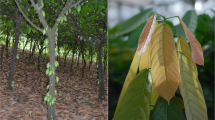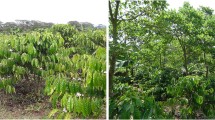Abstract
Southern Africa, and specifically its western parts is dominated by low rainfall areas, and it is expected that the rainfall in most of these parts will in future decrease further due to climate change. Woodlots of fast-growing, non-invasive tree species can provide the opportunity to produce wood and release the pressure on natural woodlands, while creating much needed income to inhabitants. Over the last two decades several trials of Eucalyptus species that could potentially withstand arid conditions were established on the South African west coast. The three most promising genotypes according to their volume growth were selected among 46 pure and hybrid species from two 20-year-old trials for further evaluation. These included 10 Eucalyptus grandis × Eucalyptus camaldulensis hybrid trees, 9 Eucalyptus gomphocephala trees, and 9 Eucalyptus cladocalyx trees for a total of 28 trees. The objective of the study reported here was to investigate the within-tree and between species variability of selected physical and processing properties determining the suitability of these three species for lumber production. The density, microfibril angle, spiral grain angle, MOE, MOR, radial and tangential shrinkage, twist, bow, splitting, and collapse were measured in a radial and longitudinal gradient. Valuable insights were gained which could provide decision support for planting, processing and further research on these species when grown in arid conditions. The E. grandis × camaldulensis hybrid was inferior in terms of most relevant properties to the other two species evaluated. The main shortcoming of both E. gomphocephala and E. cladocalyx was the high levels of twist in lumber.







Similar content being viewed by others
References
Banks CH, Otto KP, Van Vuuren WFJ (1976) The mechanical properties of timbers with particular reference to those grown in the Republic of South Africa. South African Forestry Research Institute. Bulletin 48:1–88
Bhat KM, Bhat KK, Dhamodaran TK (1990) Wood density and fiber length of Eucalyptus grandis grown in Kerala India. Wood Fiber Sci 22(1):54–61
Blakemore P (2004) Density and shrinkage of four low-rainfall plantation-grown eucalypts. Aust For 67(3):152–155
Blakemore P, Waugh G, Northway R, Washusen R (2003) High value, solid wood products from low rainfall (450–650 mm/year) farm forestry. A report for the RIRDC/Land and Water Australia/FWPRDC Joint Venture Agroforestry Program. Publication No. 03/022. Project No. PN 99.2002
Boland DJ, Brooker MIH, Chippendale GM, Hall N, Hyland BPM, Johnson RD, Kleinig DA, McDonald MW, Turner JD (2006) Forest trees of Australia. CSIRO Publishing, Collingwood
BS 373:1957 (2008) British Standard. Methods of testing small clear specimens of timber
Chafe SC (1990) Effect of brief presteaming on shrinkage, collapse and other wood-water relationships in Eucalyptus regnans E Muell. Wood Sci Technol 24:311–326
CIFOR (2011) Centre for International Forestry Research webpage. http://www.cifor.org/events/dry-forests.html. Accessed 15 Nov 2011
Cookson LJ (2004) The in-ground natural durability of Australian timbers. Report project PN04.1004. Forest and Wood Products Research and Development Corporation. Australian Government. p 12
Donaldson L (2008) Microfibril angle: measurement, variation and relationships—a review. IAWA J 29(4):345–386
Ellis F (1995) Drought resistance of Eucalyptus species/provenances on sandy soils along the dry South African Cape West Coast: a case study. In: Schulte A and D Ruhiyat (eds) Proceedings of International Congress of Tropical Forest Ecosystems. Third conference on forest soils. Balikpapan, Indonesia, pp 106–114
Ellis F, Van Laar A (1999) Nutrient levels of three eucalyptus species provenances, measured over four seasons in a trial along the sandy, dry, Cape west coast of South Africa. South Afr For J 184:33–40
Evans R, Ilic J (2001) Rapid prediction of wood stiffness from microfibril angle and density. For Prod J 51(3):53–57
Evans R, Stringer S, Kibblewhite RP (2000) Variation of microfibril angle, density and fibre orientation in twenty-nine Eucalyptus nitens trees. Appita J 53(5):450–457
Famiri A, Kabouchi B, Baillères H, El Abid A, El Alami S, Hakam A (2011) Effect of standing trees girdling on the fissurations propagation and sawing distortions for two eucalyptus species: E. grandis and E. gomphocephala. Phys Chem News 59:65–72
FANR (2011) SADC Food Agriculture and Natural resources webpage http://www.sadc.int/fanr/naturalresources/forestry/management.php. Accessed 5 Oct 2011
FAO (1989) Arid zone forestry: a guide for field technicians. http://www.fao.org/docrep/t0122e/t0122e00.htm#Contents. Accessed 21 Oct 2014
FAO (2014) Food and agriculture organization ecocrop database. Webpage http://ecocrop.fao.org/ecocrop/srv/en/home. Accessed 13 Oct 2014
Ferrari G (1995) Variation in Eucalyptus sp. wood properties with tree height. Econ Mont Linea Ecol 27(5):53–58 (in Italian)
Foslie M (1971) Strength properties of Norway spruce. Part 3—strength properties of small defect free specimens. Report No 42. Norwegian Institute of Wood Technology (in Norwegian)
French J, Conn AB, Batchelor WJ, Parker IH (2000) The effect of fibril angle on some handsheet mechanical properties. Appita J 53:210–217
Githiomi JK, Kariuki JG (2010) Wood basic density of Eucalyptus grandis from plantations in central rift valley, Kenya: variation with age, height level and between sapwood and heartwood. J Trop For Sci 22(3):281–286
Ilic J (1999) Shrinkage-related degrade and its association with some physical properties in Eucalyptus regnans F Muell. Wood Sci Technol 33:425–437
Jacobs MR (1955) Growth habits of the Eucalypts. Commonwealth Forestry and Timber Bureau, Canberra
Le Roux PJ (1975) Afforestation in low rainfall areas. S Afr For J 93:1–6
Lima JT, Breese MC, Cahalan CM (2004) Variation in microfibril angle in Eucalyptus clones. Holzforschung 58:160–166
Lundqvist SO, Grahn T, Olsson L (2013) Properties of materials from birch—variations and relationships. Part 1: growth, wood density and biomass. Innventia Report No 390
Malan FS (1984) Studies on the phenotypic variation in growth stress intensity and its association with tree and wood properties of South African grown Eucalyptus grandis (Hill ex Maiden). Dissertation, University of Stellenbosch
Malan FS (1993) The wood properties and qualities of three South African-grown Eucalypt hybrids. S Afr For J 167:35–44
Malan FS (2003) The wood quality of the South African timber resource for high-value solid wood products and its role in sustainable forestry. South Afr For J 198:53–62
Munalula F, Meincken M (2009) An evaluation of South African fuelwood with regards to calorific value and environmental impact. Biomass Bioenergy 3(3):415–420
Ozarska B (2009) Engineering properties of selected young plantation-grown Australian hardwoods for furniture. For Prod J 59(7–8):27–30
Phiri D, Ackerman PA, Wessels CB, Johansson M, Säll H, Lundqvist S-O, du Toit B, Seifert T (2015) Biomass equations for selected drought tolerant eucalypts in South Africa. South For. doi:10.2989/20702620.2015.1055542
Potts BM, Dungey HS (2004) Interspecific hybridization of Eucalyptus: key issues for breeders and geneticists. New For 27(2):115–138
Roux J, Hurley BP, Wingfield MJ (2012) Diseases and pests of eucalypts, pines and wattle. In: Bredenkamp B, Upfold SJ (eds) S Afr For Handb, 5th edn. Published by the Southern African Institute of Forestry, Menlo Park, pp 303–335
Säll H (2002) Spiral grain in Norway spruce. Acta Wexionesia No. 22/2002. ISBN: 91-7636-356-2. Dissertation, Växjö University
SANS 1783‐1 (2009) South African National Standard. Sawn softwood timber. Part 1: General requirements
SANS 1783‐3 (2010) South African National Standard. Sawn softwood timber. Part 3: Industrial timber
Stern-Cohen S, Fahn A (1964) Structure and variation of the wood fibres of Eucalyptus gomphocephala along and across the stem. La Yaaran 14(4):132–133
Stuart S, Evans R (1994) X-ray diffraction estimation of the microfibril angle variation in eucalypt wood. Appita J 48:197–200
Taylor FW (1973) Variation in anatomical properties of South African grown Eucalyptus grandis. Appita 27:171–178
Thinley C, Palmer G, Vanclay JK, Henson M (2005) Spiral and interlocking grain in Eucalyptus dunnii. Holz Roh-Werkst 63:372–379
Tribe GD (2005) The present status of Anaphes nitens (Hymenoptera: Mymaridae), an egg parasitoid of the Eucalyptus snout beetle Gonipterus scutellatus, in the Western Cape Province of South Africa. South Afr For J 203(1):49–54
Van Wyk G, Van Laar A, Theron JM (2001) Yield potential of selected Eucalyptus genetic stock on the sandy soils of the South African Cape west coast. South Afr For J 191(1):9–19
Vermaak GS (1979) Service tests of telephone poles of ten Eucalyptus and Three Pinus species. S Afr For J 109(1):26–31
Vermaas HF, Bariska M (1994) Collapse during low temperature drying of Eucalyptus grandis W. Hill and Pinus silvestris L. In: Proceedings IUFRO Wood Drying Conference, Rotorua, New Zealand 141–150
Von Doderer CCC, Kleynhans TE (2010) Financial viability of agroforestry for bioelectricity generation on various farm types in the Western Cape South Africa. Agrekon 49(2):168–194
Washusen R, Waugh G, Hudson I (1996) Wood products from low-rainfall farm forestry. Forest and Wood product Research and Development Corporation. Project report PN 007.96
Wimmer R, Downes M, Evans R (2002) Temporal variation of microfibril angle in Eucalyptus nitens grown in different irrigation regimes. Tree Physiol 22:449–457
Yang JL, Evans R (2003) Prediction of MOE of eucalypt wood from microfibril angle and density. Holz Roh Werkst 61(6):449–452
Acknowledgments
Our appreciation to the following persons who helped with field work and measurements during this study: Mark February, Anna Clarin, Wilmour Hendrikse, Emile Kitenge, Robert Mupamba, Lars Olson, and Nils-Olaf Petersen. We gratefully acknowledge funding for the study by the Swedish International Development Agency (SIDA) and co-funding by Research Institutes of Sweden (RISE).
Author information
Authors and Affiliations
Corresponding author
Rights and permissions
About this article
Cite this article
Wessels, C.B., Crafford, P.L., Du Toit, B. et al. Variation in physical and mechanical properties from three drought tolerant Eucalyptus species grown on the dry west coast of Southern Africa. Eur. J. Wood Prod. 74, 563–575 (2016). https://doi.org/10.1007/s00107-016-1016-3
Received:
Published:
Issue Date:
DOI: https://doi.org/10.1007/s00107-016-1016-3




